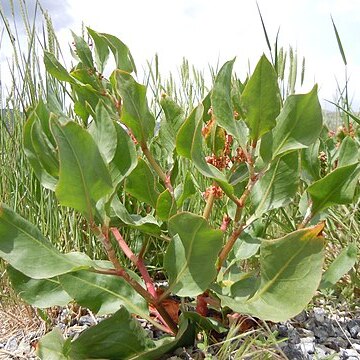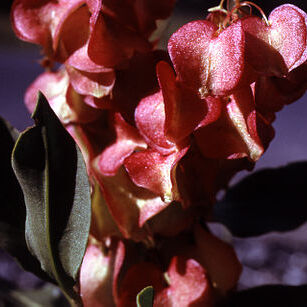Plants perennial, glabrous or nearly so, with creeping rhizomes. Stems ascending or, rarely, erect, usually producing axillary shoots near base, (10-)15-30(-40) cm. Leaf blades ovate-elliptic, ob-ovate-elliptic, or ovate-lanceolate, (2-)4-12(-15) × 1-5(-6) cm, subcoriaceous, base narrowly to broadly cuneate, margins entire, flat or slightly undulate, apex acute or acuminate. Inflorescences terminal and axillary, usually occupying distal 2/ 3 of stem/shoot, usually dense, or interrupted in proximal part, broadly paniculate. Pedicels articulated near middle, filiform or slightly thickened, (8-)10-16 mm, articulation distinct, slightly swollen. Flowers 5-15 in whorls; inner tepals distinctly double-reticulately veined, orbiculate or reniform-orbiculate, 13-18(-20) × (20-)23-30 mm, base deeply emarginate or cordate, margins entire, apex rounded, obtuse, rarely subacute, with short, broadly triangular tip; tubercles absent, occasionally very small. Achenes brown or dark brown, 5-7 × 4-6 mm. 2n = 40.
More
A small herb. It grows 10-45 cm high. It has woody rootstock that forms runners. The leaves are alternate and simple. The stipules form sheaths. The leaves are 5-12 cm long. The flowers are greenish and small. Many flowers occur together in clusters at the ends of the stalk. The fruit is 3 angled. They are papery and with strong veins.
Glabrous, rhizomatous perennial 2–6 dm; lvs ovate to oblong or lanceolate, flat, entire, 4–12 cm; infl very dense in fr; pedicels weakly jointed near midlength; valves rose-color, 1.5–2 × 2–3 cm, without grains; 2n=40. Dry soil in waste places; native of w. U.S., rarely adventive in our area.
Sand dunes, sandy and gravelly riverbanks and slopes, deserts, grasslands at elevations from 200-1,500 metres.
More
It is a temperate plant. It grows in dry sandy soil.


